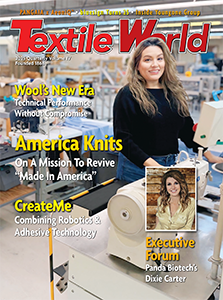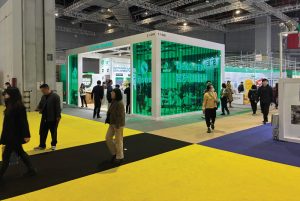
TESTEX® showcased the latest policies and tailor-made services for the textile industry at Intertextile.
Shanghai’s National Exhibition and Convention Center hosted more than 4,030 exhibitors across three Messe Frankfurt collocated textile expositions — Intertextile Shanghai Apparel Fabrics, Intertextile Shanghai Home Textiles and Yarn Expo.
TW Special Report
Three Messe Frankfurt collocated textile expositions — Intertextile Shanghai Apparel Fabrics, Intertextile Shanghai Home Textiles and Yarn Expo — recently gave more than 4,030 exhibitors the opportunity to connect with visitors from more than 131 countries and regions.
The sheer enormity of the of the concurrent show’s footprint was still dwarfed by the size of the venue — the National Exhibition and Convention Center (NECC) (Shanghai) — which at 15.8 million square feet is the largest convention center of its kind in the world.
Taking place in early spring, the shows occurred prior to U.S. tariff announcements and had the air of the established international trading history of the past.
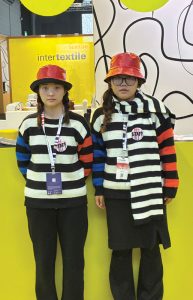
Rooted In Commerce
Exposition organizer Messe Frankfurt (HK) Ltd. is owned by Germany-based Messe Frankfurt GmbH, which is one of the largest fair organizers in the world with its huge global footprint and 800 years of history.
The first Frankfurt, Germany-based fair was initiated by Royal Charter in 1240 by Emperor Fredrick II supporting the welfare of traveling merchants, providing a safe environment for business and promoting trade. In 1330, Emperor Louis IV continued the support of the event and as the city of Frankfurt grew through the years, so did its influence in commerce.
After World War II, the fair entered the modern era with its first post-war show in 1948, which gave rise to Messe Frankfurt. From there the company’s list of shows grew to include Heimtextil and Interstoff with an evolving international presence. Today, Messe Frankfurt is a leader in international trade fairs and exhibitions across a variety of industries including textiles.

Intertextile Shanghai Apparel Fabrics
Wendy Wen, managing director, Messe Frankfurt (HK) characterized the recent Shanghai events by saying: “We were pleased with the high visitor flow at all three shows, as well as the positive exhibitor feedback overall and for new elements such as Econogy Hub. Across numerous platforms, Messe Frankfurt’s global Texpertise Network of 500,000 participants puts us in a great position to observe the market and seize new opportunities when they emerge.”
Intertextile Shanghai Apparel Fabrics
Intertextile Shanghai Apparel Fabrics was first launched in 1995. Formerly known as Intertextile Shanghai Fair, it was established in cooperation with the Sub-Council of Textile Industry, China Council for the Promotion of International Trade (CCPIT TEX); and China Textile Information Centre.
The spring 2025 iteration offered 3,100 exhibitors from 25 countries and regions the opportunity to engage with a near record setting number of visitors.
Aisles upon aisles of exhibitors — large and small, as well as well-known and unfamiliar — drew nearly 95,000 attendees from 131 countries and regions.
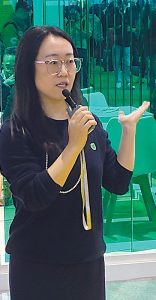
Concurrent Shows
Intertextile Shanghai Apparel Fabrics was conveniently located adjacent to the Intertextile Shanghai Home Textiles Spring Edition and Yarn Expo at the NECC. This made exploring the three events more manageable, but a deeper dive would take considerable time.
Intertextile Shanghai Home Textiles Spring Edition
Organized by Messe Frankfurt (HK), CCPIT TEX and the China Home Textile Association (CHTA), Intertextile Shanghai Home Textiles Spring Edition featured more than 370 exhibitors engaged with some 25,000 visitors from 85 countries and regions. Visitor numbers increased 8 percent; and organizers noted that the number of international visitors was more than double that of the previous spring edition.
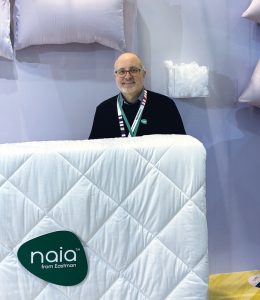
The show focuses on bedding, toweling, curtains, carpets, rugs, upholstery and more. There were a full range of brands and suppliers present with eight major Chinese home textile pavilions.
Chu Yajun, sales manager, Shanghai Ruiping Trading Co. Ltd. — which is the global authorized dealers of St. Paul, Minn.-based 3M™’s Thinsulate™ insulation — stated: “We are promoting four Thinsulate models for home textiles, along with various functional options like anti-allergy and antibacterial products. This show is well regarded, attracting both domestic and international customers. Foreign brands are increasingly interested in eco-friendly features, a trend that local customers are also adopting. Thus, we prioritize environmental protection, innovation, and functionality in our product development.”
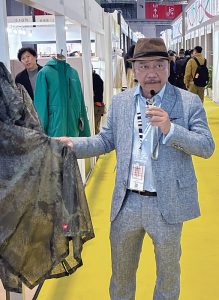
Spring edition visitor Shirley Xu, merchandise manager, Americana International (Shanghai) Ltd., USA reported to the organizer: “Specializing in home textiles like bedding sets and cushions, we’re seeking exhibitors who prioritize patterns and functionality, especially fashionable prints. The fringe events are beneficial for keeping us updated on popular market trends. I’ve noticed the Chinese market aligning more with international standards, and this show features a diverse range of both local and foreign exhibitors.”
Fringe Speakers’ Insight
Designed to share the latest textile knowledge and development, the Intertextile Apparel Fringe Program covered four core themes — on-trend fashion, functionality, sustainability and digitalization. Panel discussion topics included Econogy Talks, Technology and Solutions, and Design and Trends. During the Econogy Talks segment, certifiers, producers, industry experts, among others spoke about solutions, best practices and challenges related to sustainability in the apparel sector.
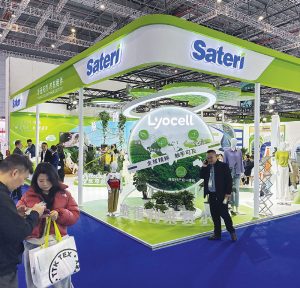
“Our decision to participate in this seminar stems from our long-standing involvement with Intertextile,” said Laurie Pressman, vice president, Pantone Color Institute, Carlstadt, N.J., who participated in the Fringe Speakers Program. “We’ve been attending for many years because it serves as a vital platform in the home textiles and fashion industries. This year, we had the opportunity to present trends specifically for home textiles, which is particularly exciting as we’ve been forecasting colors for the home furnishings market for over two decades. Conducting seminars like this allows us to share our color intelligence, helping manufacturers understand which colors consumers’ desire.”
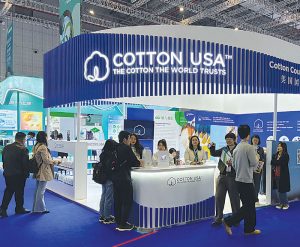
Yarn Expo Spring 2025
Yarn Expo also set a record with 562 exhibitors from 13 countries and regions — an exhibitor increase of 6 percent from the previous edition. China, Germany, Hong Kong China, India, Indonesia, Pakistan, Singapore, Taiwan China, Türkiye, United Arab Emirates, United Kingdom, Uzbekistan, and Vietnam were all represented.
Nearly 24,000 visitors networked with suppliers presenting their latest collections of natural, regenerated, and man-made fibers and yarns, as well as specialty products including elastic, and fancy and blended yarns.
The 27,000 square meter show floor was arranged into six zones including Cashmere Yarn, Fancy Yarn, Chemical Fiber, Green Linen & Quality Wool Yarn, Cotton Yarn, and International Yarn, and also included Pakistan and India pavilions.
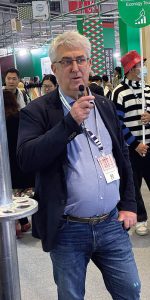
One of the biggest exhibition stands housed man-made cellulose fiber producer Sateri (Fujian) Fibre Co. Ltd. The company is one of world’s largest producers of viscose fiber, which is often used in traditional textiles, wet wipes and hygiene products. With five mills in China, the company is reported to collectively produce approximately 1.8 million tons of viscose fiber annually.
Notably there were 90 exhibitors in the cotton zone of Yarn Expo, and exhibitors also included those show-casing new materials and high-performance fibers.
A major, consistent theme among exhibitors was “green” products, a focus on sustainability and a call out to circularity in the textile supply chain.
Looking Forward
In the face of turbulence in international trade, the current environment casts shade on what was a well-attended — based on both exhibitor and visitor numbers — triumvirate of textile exhibitions.
That said, if history informs us, Messe Frankfurt has more than weathered such storms in its past and regardless of the form the business landscape takes going forward, supporting the welfare of traveling merchants, providing a safe environment for business, and promoting trade will continue as it started more than 800 years ago.
As Wen stated, “With economic challenges and evolving industries to navigate, trade fairs will be as important as ever, and we look forward to facilitating good business in the years to come.”
2025 Quarterly Issue II

